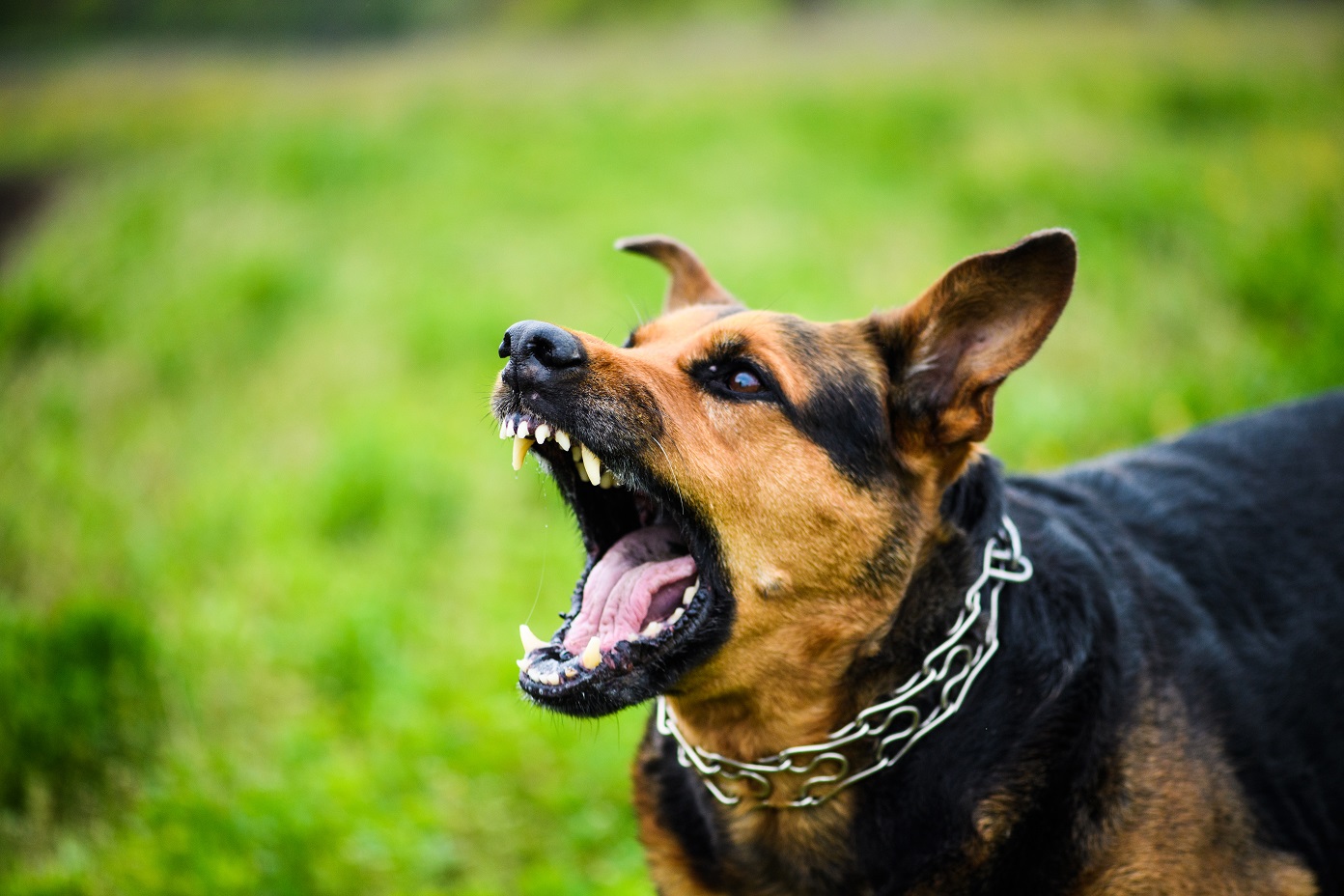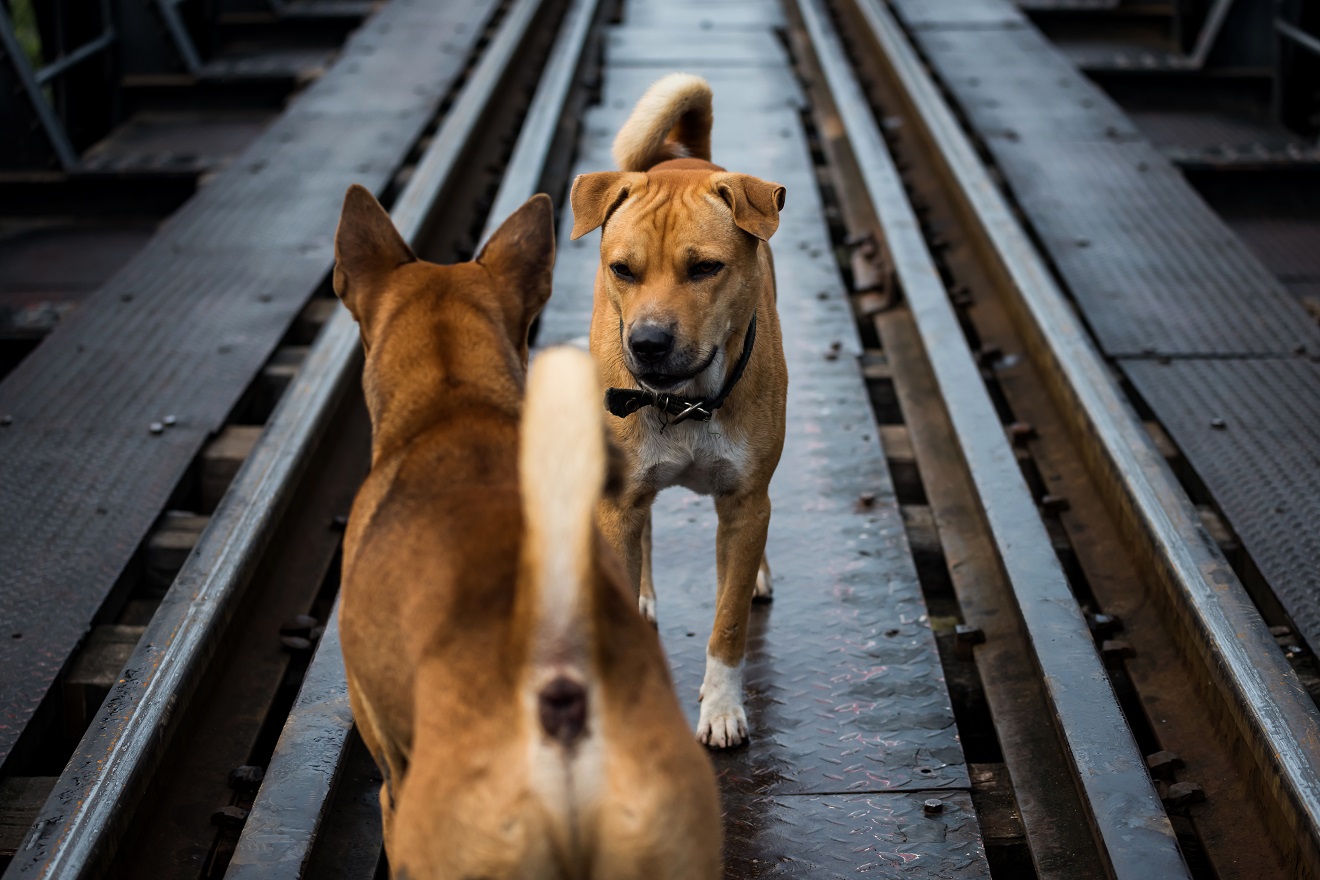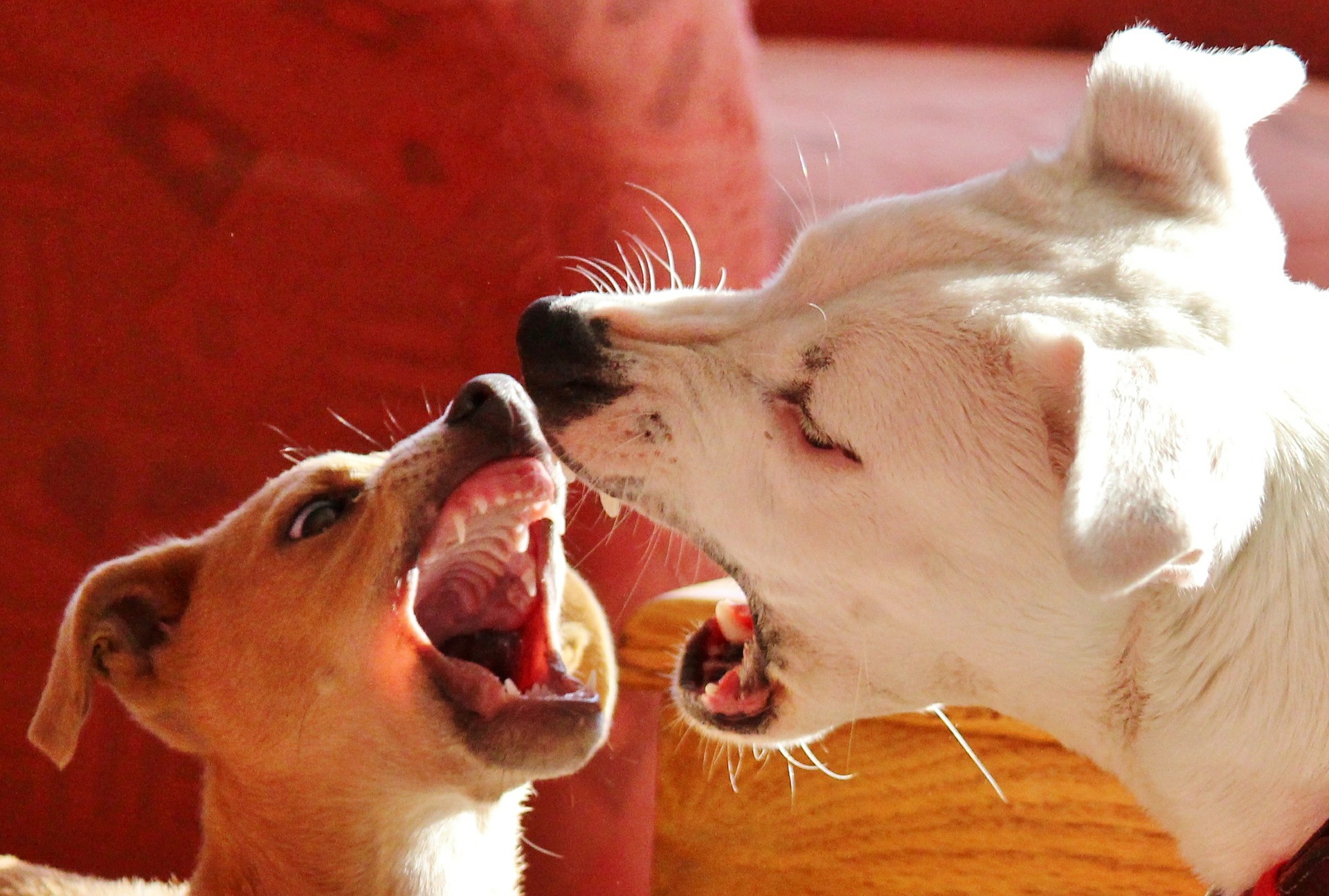True story… A while back I was dealing with a client whose dog barks at other dogs.
And when I say barks, I’m talking about excessive, uncontrollable barking that was impossible to contain whenever other dogs were in the area.
Now, if your sick and tired of your dogs frustrating, annoying barking habits, then it’s time to get pro-active.
Because while all dogs bark, there’s a world of difference between a dog that barks a friendly hello, to one that turns every walk into a howling nightmare.
You know the feeling… you’re walking along quite nicely, and then suddenly, another dog approaches.
And that calm, sedate dog by your side explodes into a frenzy of barking. Quite possibly, there’s a fair amount of lunging involved as well.
But even if there’s not, the barking alone is enough to make you feel you’re losing your mind… and to seriously wonder whether your dog’s already lost theirs.
Don’t worry, they haven’t. And there’s plenty you can do to cut the barking and reintroduce some sanity into your life.
Barking at other dogs is a surprisingly common behavior problem. It’s also one that surprisingly easy to solve.
Here’s how you do it.
WATCH VIDEO: Aucklands Top Dog Trainer Reveals How To Quickly & Permanently Stop Your Dogs Obsessive Barking Habits Using 5 Step-By-Step Exercises Proven To Instantly Calm Your Dog…
(video will open in a new window)
General Reasons for Excessive Barking
Ultimately, barking is perfectly normal behavior. It’s how dogs communicate, both with you and with other dogs.
But when that barking goes from ‘normal’ to excessive’, it suggests something is going on… something you probably need to know about.
Some of the most common reasons for problematic barking include:
Boredom
When WE get bored, it’s usually by choice. Most of us have enough things to do and places to go to keep us plenty occupied.
But dogs… well, dogs don’t have the luxury of Netflix for one.
But canines are clever. They don’t appreciate staring at the same four walls every day. If your dog isn’t provided enough in the way of physical and mental stimulation, they’re going to get bored.
And a bored dog is a frustrated dog. Let them wallow in their frustration for too long, and they’ll soon become destructive, badly behaved, and very, very loud.
Separation Anxiety
Some dogs hate being left alone. Like, really hate it. Hate it to the point that they’re willing to summon the whole neighborhood with their barks in order to avoid it.
Treating a dog with separation anxiety can be a lengthy process, but as the first port of call, I’d recommend taking a look at these 5 step by step calming exercises. Used regularly, they can help turn an anxious pooch into a well-adjusted, happy one.
Territorial Behavior
Most dogs think the only thing standing between you and an intruder is them. If they spot a squirrel acting suspiciously or a mailman malingering at your mailbox, they see it as their duty to inform you.
And short of learning how to use a phone, the only way they can do this is by barking.
Attention-seeking Behavior
Some dogs are demanding. They want your attention, they want it now, and they’ll stop at nothing to get it.
Sometimes, this manifests itself in less than desirable ways, including (but not limited to) barking.


But Why Does My Dog Bark at Other Dogs?
As we’ve already seen, some dogs bark for reasons that have nothing to do with other dogs.
But in other cases, it’s only the sight of other dogs that whips them into a frenzy.
If your dog only kicks up a fuss when they come into contact with other members of the canine kingdom, it could be for one of any number of reasons, including:
The Fight or Flight Response
If you walk your dog on a leash, you’re doing the right thing. But inadvertently, you might also be creating a situation in which your dog feels compelled to bark.
Why?
Because of a little thing called the flight or fight response.
Maybe your dog is naturally a little nervy. Maybe they’ve had a bad experience with another dog in the past. Whatever the reason, seeing another dog approach isn’t a welcome sight. They want them gone, fast.
And that’s where the fight or flight response kicks in. But with a leash around their neck, there’s no chance to flee. So, what do they do instead?
Bark, lunge and do everything in their power to get that other dog to run for the hills, obviously. And once they learn it works… well, they just keep doing it.
The Want to Say Hello
When dogs are still in the tiny, cute stage, most of us are perfectly happy to let them wander up to other people and pets and say hello. No one can resist a pup, and no one’s going to mind a friendly greeting from one.
But once they lose the puppy fat and develop muscles, we worry that not everyone wants a strange dog wandering up to them. Neither do they want one wandering up to their own dog. So, we pop a leash on them and pull them away whenever they get near.
But your dog still remembers a time when saying hello with a sniff and a lick was a good thing. And they don’t understand why they can’t do it anymore. So, they get frustrated. And when a dog gets frustrated, it’s only a matter of time before the barking starts.


A Lack of Socialization
Not all dogs are born with an innate understanding of how to behave in public. Neither are they born knowing how to deal with other dogs politely.
They have to be taught.
And the only way to do that is by socializing them, as often and from as early an age as possible.
If a dog misses out on early socialization, it’s normal for them to become shy and nervous around other dogs. Some will cower away from potential playmates. Others will puff out their chests, bark like a maniac, and put on a peacock display of aggression to mask their fear.
Poor Training Techniques
If you ever hear a dog trainer say punishment works as a training technique, run for the hills.
Punishment or corrective training techniques only serve to make a bad situation worse.
If you or anyone else has ever scolded, spanked, or pulled harshly on a leash to stop your dog from barking at other dogs, your pet has been conditioned to see other dogs as the forerunner to something bad happening.
It’s only natural, then, that they’re going to try and keep that dog away by any means they can.
A Combination of Factors
All these reasons boil down to one of three things: stress, excitement, or fear. You might never be able to pinpoint the exact reason for your dog’s barking problem, but it actually doesn’t really matter.
There IS a reason, your dog’s not mad, you don’t have to keep them under lock and key for the rest of their life. And with a bit of effort, you’ll soon have it under control.
Which brings us nicely round to the big question of the day… how do you stop your dog barking at other dogs?


How to Stop Your Dog Barking at Other Dogs
Regardless of whether your dog’s barking because they’re stressed, they’re excited, or they’re scared, the steps to fix the problem are much of a muchness… which, as you’d expect, makes treatment that much easier.
But don’t think this is going to be a picnic. Dog’s don’t drop ingrained habits overnight. This is a process that might take some time.
Until your dog learns to stay mum, you’re going to need to stay calm and carry on. And so’s your dog. To help support them as they move through the training, take some time to teach them (and yourself!) a few calming techniques – if you haven’t already, I’d recommend checking out these 5 step-by-step calming exercises.
Learn the Power of Positive Reinforcement
Negative reinforcement doesn’t work. Never has, never will.
Positive reinforcement, on the other hand, is the bedrock of effective training.
Regardless of what training technique you use, always reward your pet for positive progress. Whenever they see but don’t react to another dog, show how proud you are by treating them to something tasty.
The aim of the training is to teach your dog to be calm around other dogs: by rewarding them when they are, they’ll learn that good behavior results in good things happening. Once they get that message, you’ll be one step closer to your goal.
Teach Basic Obedience
If your dog has never been properly trained, it’s time to start.
Start by teaching them the ‘speak’ command. Say ‘speak’ then follow up with something that makes them bark, like knocking on the door or pulling out their favorite game. After a few barks, pop a treat in front of their face and reward them with it once they stop barking.
Keep practicing until your dog has the ‘speak’ command down to a tee.
Next, introduce them to the word ‘quiet’. The principle works the same as before – simply do something to make them bark, issue the ‘quiet’ command, and keep a treat in front of their nose until they stop. Once they do, let them loose on the treat.
Start by practicing at home or in other areas where there’s unlikely to be other dogs. Once they’re au fait with the training, start practicing it whenever and wherever you might come across other dogs.


Respect their Threshold
During the early days of training, it’s vital to pay attention to your dog’s comfort threshold around other dogs.
If 5 meters is as close as they can get to another dog before barking, then stick to 5 meters. Going any closer will push your dog into a heightened state of arousal – once that happens, the chances of you being able to teach them anything at all is slim to none.
Worse still, it might inadvertently lead you to reinforce your dog’s behavior.
It’s likely that once your dog starts barking maniacally, you pull them away and move in another direction to the dog.
The result? Your dog is sent the message that barking gets them what they want. Once they know that, why would they ever stop?
Try Some Classic Counter-Conditioning
The aim of counter-conditioning is to replace a negative response to a certain stimulus with a positive one. In other words, it changes how your dog ‘feels’ about something.
In this case, it can be used to change your dog from feeling scared, anxious, or aggressive around other dogs to feeling calm, happy, or completely indifferent.
For it to work, you’re going to need two things:
- An understanding of how close you can get to another dog before your own starts to bark.
- A very big bag of treats.
When you’re next on a walk, keep an eye out for any dogs. When one gets close to your pet’s comfort threshold, whip out the bag of treats and start pumping them into your dog.
Carry on practicing whenever possible. Keep a careful eye on your dog’s reaction each time. Once they can stay calm when another dog crosses slightly over the threshold, they’re ready to move onto the next stage.
From here, it’s a case of reducing the threshold in small, incremental steps. Start gradually – thinking you can go from 50 feet to 2 feet overnight is setting yourself up for failure.
Go slow, go steady, and go, go, go with the treats. Once your dog is able to stay calm when another dog walks directly by, you’re on the home run.
Final Thoughts
Annoying though it can be, excessive barking around other dogs isn’t that uncommon. Actually, it’s anything but.
And fortunately, it’s not something you just have to learn to live with. Training your dog to abandon an ingrained habit can be challenging, but it’s by no means impossible.
Just remember that no matter how frustrating it gets, never let your dog feel your frustration. Shouting “No” and pulling them away can feel the natural response, but it’ll only serve to reinforce the unwanted behavior.
Keep positive, keep patient, and keep persevering. And in the meantime, there’s always earplugs.
WATCH VIDEO: Aucklands Top Dog Trainer Reveals How To Quickly & Permanently Stop Your Dogs Obsessive Barking Habits Using 5 Step-By-Step Exercises Proven To Instantly Calm Your Dog…
(video will open in a new window)

